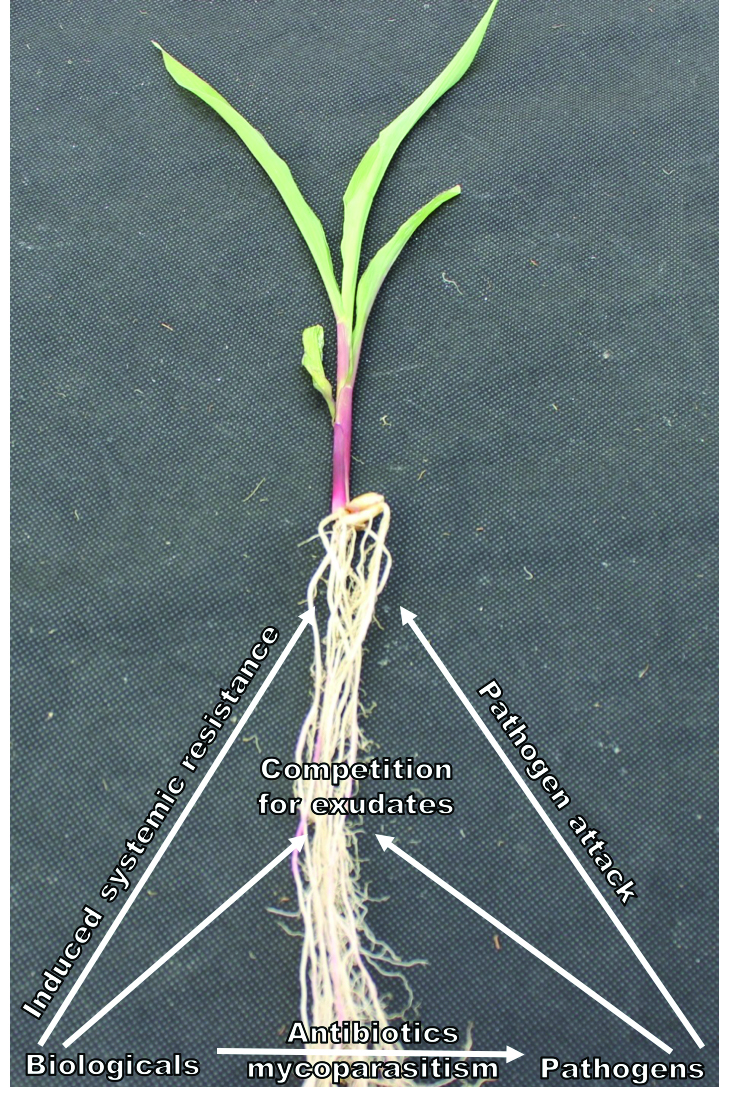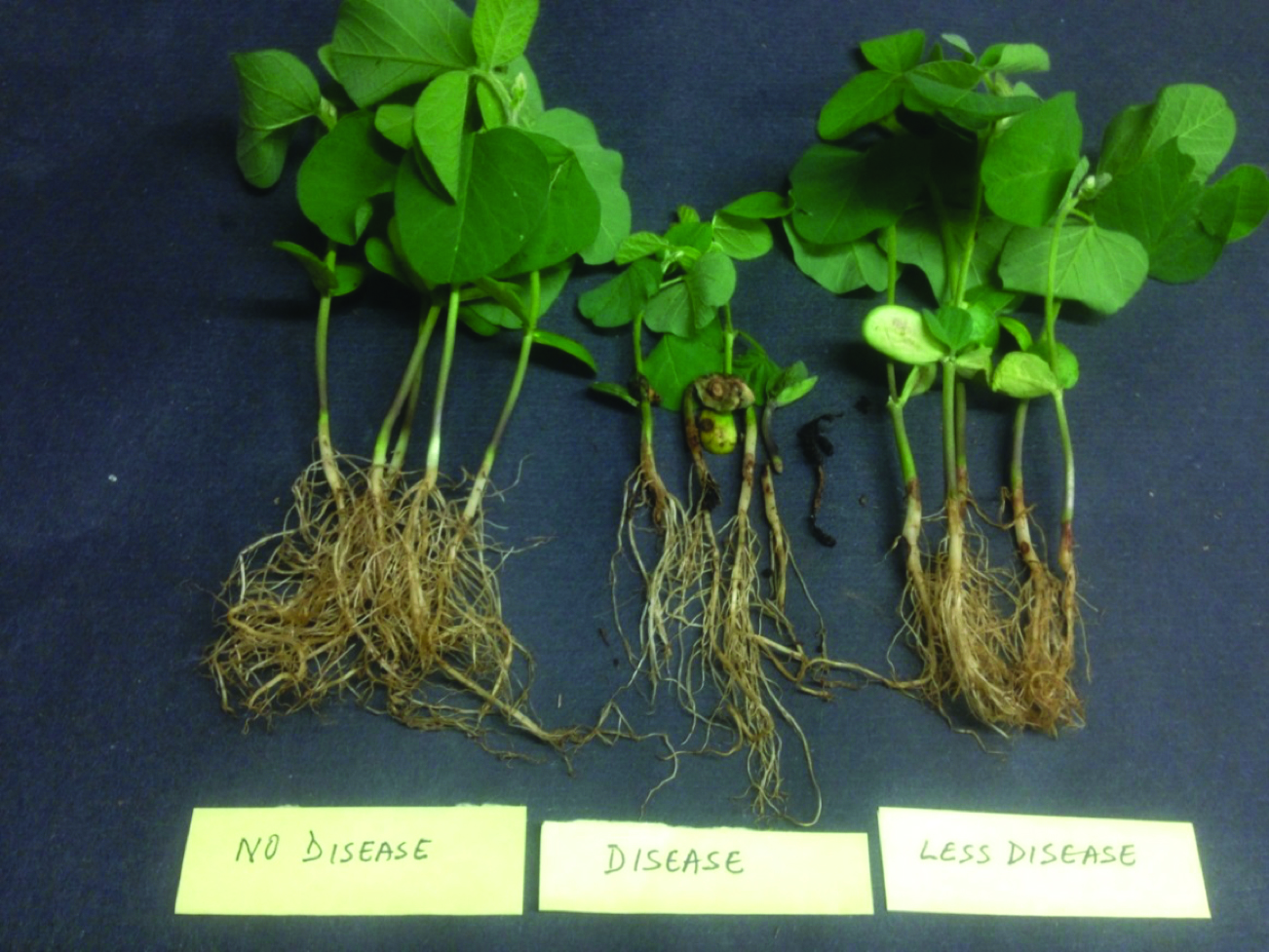

Tony O. Adesemoye, Extension Plant Pathologist
Plant pathogens and their associated diseases are major limitations to crop production. The use of chemical pesticides has traditionally been the most important option for disease management. However, several biological and cultural management options are available to producers. Developing an integrated pest management (IPM) system that combines biological, chemical, and cultural control options for disease management is efficient, economical, and very attractive for better crop quality and environmental sustainability. This publication focuses on biological products that can be integrated into plant disease IPM strategies for field crops.
Biological products are those that contain naturally occurring beneficial microorganisms, or their derivatives, as active ingredients. The terms “biologicals” and “beneficial microorganisms” are closely associated and will be used interchangeably in this publication. Thorough knowledge of biologicals is needed to assist growers in maximizing the effectiveness of biological products in successful disease management. This is a timely topic given the concern about pests developing resistance against chemical pesticide options. Biological products are useful tools that may help delay resistance from developing.
Disease development is dependent upon the presence of a virulent pathogen, a susceptible host crop, and favorable environmental conditions. It is essential to target these three components to manage disease development. Environmental factors that can contribute to disease development include moisture, humidity, temperature, sunlight, and soil type.
Biological products for disease management include biofungicides, biobactericides, and bionematicides to manage fungi, bacteria, and nematodes, respectively. Product development is based on different modes of action that target the pathogen, plant, or environment. While some products may use one mode of action and are specific to a pathogen group, other products are broad spectrum and involve a combination of different modes of action. These modes of action include:
Competition: Beneficial microorganisms and plant pathogens are naturally attracted to root exudates. Effective beneficial microorganisms are typically more competitive than pathogens for space and/or food, thereby reducing opportunities for the pathogen or excluding the pathogen from attacking crops (Fig. 1). In the process of using root exudates, pathogens will harm the crop. On the other hand, beneficial microorganisms will help reduce pathogen invasion on the host crop. Effective root colonization and growth of beneficial microorganisms will have a positive effect on the host crop by reducing pathogen activities or the byproducts. For example, certain biologicals can reduce the ability of plant pathogens to produce toxins that would otherwise have a negative effect on the host crop.

Fig. 1. Interactions of biologicals, a crop, and pathogens. Biologicals and pathogens compete for the exudates released by crop roots. These beneficial microorganisms may kill pathogens or reduce disease through mycoparasitism or production of antibiotics. Biologicals induce systemic resistance in the crop, which helps prevent pathogen invasion.
Killing of pathogens: Another biological mode of action is the production of enzymes or antibiotics that can reduce or eliminate pathogen populations. Beneficial fungi may also parasitize a pathogenic fungus; a process termed “mycoparasitism.” However, mycoparasitism does not always lead to death of the parasitized organism.
Obstruction of growth and reproduction: Certain biological products act by inhibiting pathogen growth or reproduction. They may not kill the pathogen, but will reduce its population. For example, a beneficial bacterium may obstruct the growth and reproduction of a nematode.
Induced or acquired resistance: The interaction between beneficial microorganisms and the host plant can initiate physiological reactions in the plant. This interaction can help the plant develop resistance to plant pathogens (Fig. 1).
Table 1. Currently available biological products for disease management
Enhanced growth: Biologicals may also indirectly protect crops by enhancing plant growth. Healthy, vigorously growing plants are better able to protect themselves from pathogen attack through natural defenses compared with weak plants, especially during the seedling stage of development. This mode of action is especially effective against early season soilborne pathogens when plants are small.
Modification of the plant’s microenvironment: When applying biologicals, the population density of a specific group of beneficial microbes is expected to increase. This will benefit the host crop’s environment and will negatively affect the pathogen, which will ultimately improve yield and crop quality. Some studies have shown that during drought stress, certain biologicals may help plants access more moisture or survive better in these conditions. Manipulating the crop’s environment using beneficial microorganisms will help to reduce its susceptibility to diseases.
Potentially beneficial microorganisms, including fungi and a group of bacteria called plant growth-promoting rhizobacteria (PGPR), have been collected from Nebraska crop fields and tested against many pathogens. A greenhouse study on the impacts of a PGPR (Bacillus sp.) on seedling root rot disease caused by Rhizoctonia solani demonstrated that root rot could be reduced with a PGPR seed treatment at planting (Fig. 2). Plants in Fig. 2 demonstrate a healthy control (left, “no disease”), plants inoculated with R. solani root rot pathogen (middle, “disease”), and plants inoculated with R. solani plus the PGPR biocontrol seed treatment (right, “less disease”).
After three weeks, seedlings inoculated with R. solani (middle) showed characteristic damping off, stunting, and visible reddish-brown lesions around the crown. One seedling died and four seedlings were severely stunted compared with the healthy control plants on the left. On the right, inoculated plus PGPR seed treatment plants showed substantially less disease symptoms and were comparable in size to the control “no disease” plants. This study is one of the many steps that may lead to the formulation of a biological product for disease management. Further testing is needed before making sound conclusions about biological agents used in this study, but results from this and future studies may aid in developing biological control products and seed treatments.

Fig. 2. Testing beneficial Bacillus species against Rhizoctonia solani in soybean
Multiple applications: It is common for biological products to require multiple applications to achieve adequate protection against pathogens.
Appropriate timing is essential: For best management practices, product applications must occur when environmental conditions are favorable. For example, most biologicals will do better when applied to moist rather than dry soils.
Use biologicals before infections: Better protection can be achieved if biologicals are applied and can colonize roots prior to pathogen invasion.
Cool but not hot conditions: Biological products are more effective when applied under cool conditions rather than during the hottest time of the day.
Use of biological products as part of an IPM system: The use of biologicals can be quite effective in an IPM strategy when combined with other options like crop rotation, tillage, and pesticide use, for example. When considering biological products, ensure that they are compatible with fertilizer or pesticide inputs. Some chemicals may be incompatible and inhibit biological productivity. For example, previously used fungicide may be incompatible with biological products being considered for the current growing season. Also, pay close attention to fungicide applications in nearby fields as drift may reduce biological activity.
Follow label instructions: It is crucial to follow label recommendations for methods of application, rate, timing, intervals, safety precautions, and maximum number of applications in a single growing season.
Table 1 lists examples of commercially available biological products for plant disease management.
| Trade Name, Biocontrol Agent, and Manufacturer | Registered Crop | Target Pathogen Group |
|---|---|---|
|
Actinovate® AG Streptomyces lydicus Novozymes BioAg, Inc. |
Corn, dry bean, dry peas, root/tuber, tomatoes |
Biofungicide against many soilborne and bacterial diseases, and some foliar pathogens |
|
Afla-Guard® GR Aspergillus flavus Syngenta Crop Protection, LLC. |
Corn, field corn, popcorn, peanuts |
Biofungicide-competes to reduce aflatoxin contamination |
|
Cease® Bacillus subtilis QST 713 BioWorks Inc. |
Seedlings, potatoes, vegetable, ornamentals |
Biofungicide, biobactericide, for foliar/soilborne diseases |
|
Clariva® pn Pasteuria nishizawae Syngenta Crop Protection, LLC. |
Soybean, sugarbeets |
Bionematicide |
|
Companion® Bacillus subtilis GB03 Growth Products, Ltd. |
Legumes, grasses, ornamentals |
Biofungicide, biobactericide, biochemical pesticide |
|
Contans® WG Coniothyrium minitans Bayer CropScience Ltd. |
Soybean, beans, sunflower, vegetables |
Microbial pesticide, biofungicide |
|
Ethos® XB Biofungicide Bacillus amyloliquefaciens D747 FMC Corporation |
Corn |
Biofungicide |
|
Integral® Bacillus amyloliquefaciens MBI600 BASF |
Soybean, vegetables, ornamentals |
Liquid biological fungicide Alternate brand: Subtilex®L |
|
Majestene® Heat-Killed Burkholderia sp Marrone Bio Innovations |
Alfalfa, apples, corn, potatoes, soybean, tomatoes, wheat |
Bionematicide |
|
Poncho®/VOTiVO® Bacillus firmus + Clothianidin Bayer CropScience Ltd. |
Corn (field, popcorn, sweet), soghum, soybean, sugarbeet |
Bionematicide Soybean Cyst Nematode |
|
Regalia® Rx Reynoutria spp. extract Marrone Bio Innovations |
Corn, soybean, wheat |
Biofungicide; biobactericide-induced systemic resistance against fungi and bacteria |
|
Rhapsody® Bacillus subtilis QST 713 Bayer CropScience Ltd. |
Corn, grasses,legumes, ornamentals, multiple crops |
Biofungicide, biobactericide |
|
Rootshield® Trichoderma harzianum BioWorks Inc. |
Multiple crops, vegetables, ornamentals |
Biofungicide for root disease control |
|
Serenade® Bacillus subtilis QST 713 Bayer CropScience Ltd. leafspot, etc. |
Corn, soybean, dry beans, vegetables, potatoes |
Biofungicide, biobactericide, Rhizoctonia root rot, white mold, gray mold, bacterial |
|
Xanthion® Bacillus subtilis BASF |
Corn (field and sweet) |
Biological fungicide for use with a chemical |
Note that some of the listed products have more than one format of the same active ingredient. Products on this table are examples of biocontrol products registered in Nebraska.
Reference to commercial products or trade names is made with the understanding that no discrimination is intended of those not mentioned and no endorsement by Nebraska Extension is implied for those mentioned.
This publication has been peer reviewed.
Nebraska Extension publications are available online at http://extension.unl.edu/publications.
Extension is a Division of the Institute of Agriculture and Natural Resources at the University of Nebraska–Lincoln cooperating with the Counties and the United States Department of Agriculture.
University of Nebraska–Lincoln Extension educational programs abide with the nondiscrimination policies of the University of Nebraska–Lincoln and the United States Department of Agriculture.
© 2017, The Board of Regents of the University of Nebraska on behalf of the University of Nebraska–Lincoln Extension. All rights reserved.